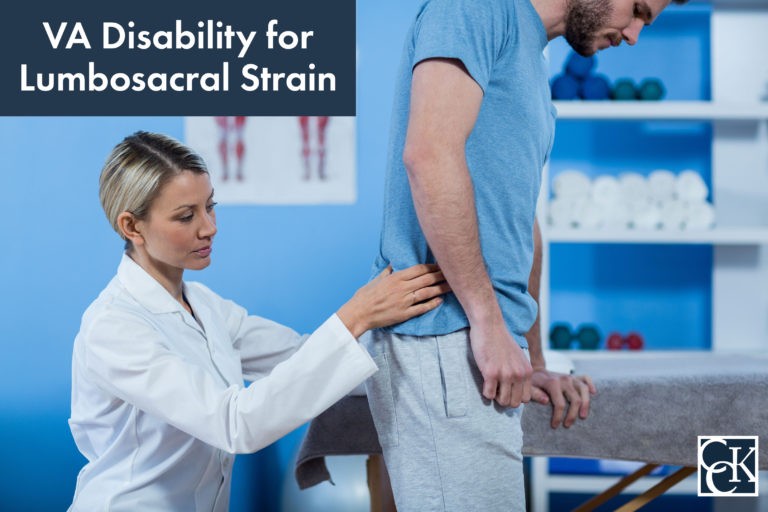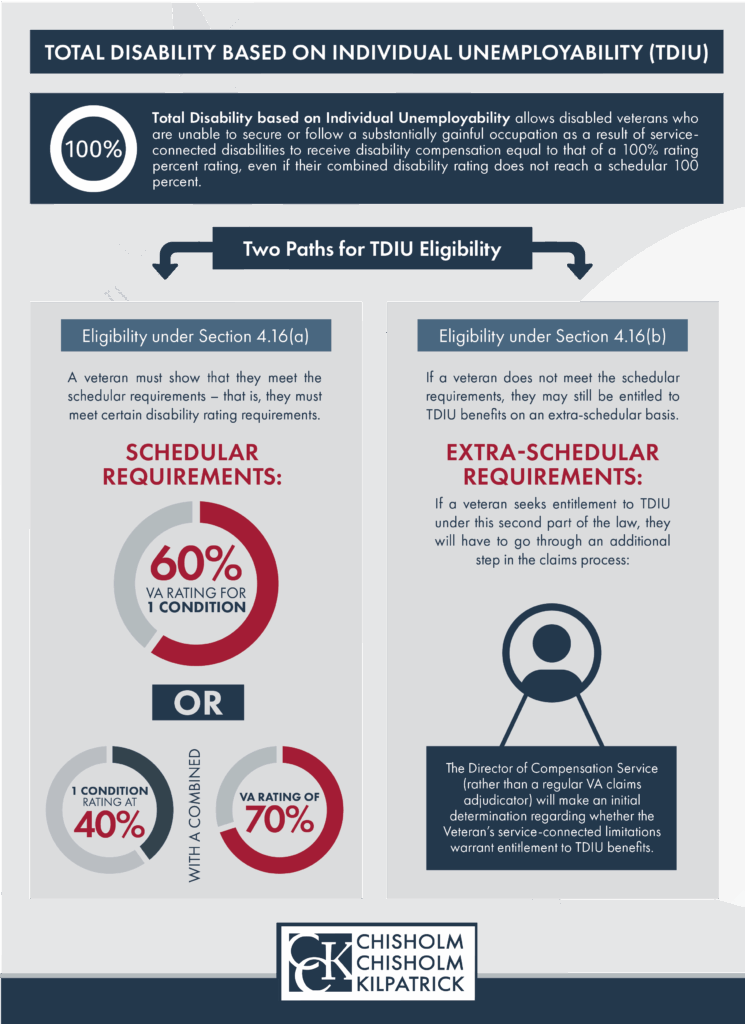Lumbosacral Strain VA Ratings and Disability

CCK Law: Our Vital Role in Veterans Law
According to the Department of Veterans Affairs (VA), approximately 1.6 million veterans were receiving disability compensation for lumbosacral or cervical strain in 2024. This makes lumbosacral strain one of the most common disabilities VA handles.
If you are a veteran contending with lumbosacral strain, then you might qualify for compensation from VA alongside over a million of your fellow service members. This article will guide you through the claims process for lumbar strain, so you can earn a lumbosacral strain VA rating and accompanying benefits.
Key points of this article include:
- Lumbosacral strain is usually rated under Diagnostic Code 5237, with rating percentages ranging from 10 to 100 percent. However, depending on your symptoms, there are alternative diagnostic codes that could be used to rate your condition.
- There are many secondary disabilities associated with lumbosacral strain, including psychological disorders, obesity, and other back conditions. Seeking out secondary service connection for these conditions could help increase your overall rating.
- Veterans with particularly severe or debilitating lumbosacral strain may also qualify for Special Monthly Compensation (SMC) or Total Disability Based on Individual Unemployability (TDIU) for increased financial benefits.
What Is Lumbosacral Strain?

A lumbosacral strain is a medical term for a tearing of muscles and tendons in the lower back (lumbosacral) region, which is a frequent cause of low back pain. Specifically, the lumbosacral area exists between the bottom of the ribcage and the top of the buttocks.
Importantly, these tears can be small but still cause a significant amount of pain. Muscles and tendons connected to the spine can be strained in a number of ways, including the following:
- Prolonged sitting or standing, particularly in the same position without alteration
- Poor posture can make low back pain and strains more likely
- Extending the muscles and tendons past their typical range of motion
- Twisting, bending, or lifting can cause strains
- Accidents or falls
In addition, there are several separate conditions that can contribute to the development of lumbosacral strain, including arthritis and obesity.
What Are the Signs and Symptoms of Lumbosacral Strain?
The most common signs and symptoms of lumbosacral strains generally include pain in the back (often on one side), pain that becomes worse with movement and improves with rest, inability to move as freely as usual, swelling, redness, and tenderness in the affected area. Lumbosacral strains are most commonly diagnosed following physical examinations, and sometimes imaging tests (e.g., MRI).
Some individuals do not need treatment for lumbosacral strains as it is possible the pain will resolve itself within several weeks; however, in many cases, the pain often comes back. Treatment for lumbosacral strains focuses on reducing pain and preventing a recurrence and/or exacerbation of symptoms. Treatment options include:
- Avoiding the cause of the strain (e.g., heavy lifting, bending repeatedly)
- Prescription or over-the-counter medications (e.g., pills, gels, creams) to reduce inflammation and pain
- Cold and heating packs
- Stretching, exercises, and physical therapy to improve flexibility and strength
- Injections (e.g., corticosteroid)
If an individual’s lumbosacral strain is severe enough, surgery may be warranted. In this case, doctors would review all courses of action and choose the most appropriate given the individual’s circumstances.
Lumbosacral Strain VA Ratings Require Service Connection
Veterans are eligible to receive disability benefits for qualifying conditions if they can establish service connection (i.e., show that their condition is due to their time in service). To establish direct service connection for a lumbosacral strain, veterans must demonstrate the following:
- A current diagnosis of a lumbosacral strain;
- An in-service event, injury, or illness; and
- A medical nexus linking the current, diagnosed lumbosacral strain to the in-service occurrence.
In most cases, veterans will undergo a Compensation & Pension (C&P) examination in order to obtain a nexus opinion. A positive nexus opinion means that the VA examiner believes “it is at least as likely as not” that the veteran’s lumbosacral strain was caused or aggravated by their time in service.
Secondary Service Connection for Lumbosacral Strain
Another form of service connection is called secondary service connection. Secondary service connection applies when an already service-connected condition goes on to cause or worsen another condition. If a veteran successfully pursues a secondary service claim, then VA will assign them a disability rating for this separate condition, treating it as an extension of their primary condition.
For example, if a veteran suffers a permanent leg injury that changes the way they walk, resulting in lumbosacral strain, then the lumbosacral strain should qualify for compensation as well.
Below is a list of conditions that are often connected to lumbosacral strain:
- Peripheral neuropathy
- Arthritis
- Sciatica
- Obesity
- Radiculopathy
- Herniated discs
- Intervertebral disc syndrome
- Spinal stenosis
- Scoliosis
- Degenerative disc disease (DDD)
- Bursitis
- PTSD
- Trouble sleeping or sleep apnea
- Bladder or bowel incontinence
- Depression and anxiety

What Evidence Should Veterans Submit for a Lumbosacral Strain VA Rating?
To build a persuasive case, it often helps to gather multiple forms of documentation:
- Service records – These can demonstrate the connection between the veteran’s condition and their time in the military. Useful records might include in-service medical reports, personnel files, discharge papers, or other official documentation.
- Medical evidence – Thorough medical records is essential for proving a lumbosacral diagnosis and describing treatment history. This may consist of records from VA healthcare providers, private physicians, or written opinions from medical professionals familiar with the veteran’s situation.
- In addition to these, veterans can submit lay statements—personal accounts from family, friends, or co-workers. While not as authoritative as official records, these statements can highlight the real-world impact of their disability and provide context to support the claim.
It is also worth noting that veterans are not expected to gather every piece of evidence on their own. Under VA’s legal “duty to assist,” the agency is required to make a reasonable effort to help veterans by requesting and assembling relevant evidence for them. It is still important and useful for veterans to identify, if not gather, as much evidence as possible.
Compensation & Pension (C&P) Exams for Lumbosacral Strain
Compensation & Pension (C&P) examinations are medical exams performed by a medical professional either working directly for VA or contracted by them. These exams are intended to help VA understand the severity of a veteran’s condition for the purposes of assigning a disability rating. They are also frequently used to determine whether the veteran’s condition is service connected.
“For C&P exams involving low back pain or conditions, the examiner will use a goniometer to measure how far the veteran can bend forward, backward, and side to side,” says Michael Lostritto, a Managing Attorney at CCK Law. “The examiner may also assess the veteran’s ability to stand, walk, sit, bend, and lift objects. The veteran’s pain levels and associated symptoms like numbness or tingling should also be probed.”
Alongside these measurements, the VA examiner will also likely perform a general physical exam, ask about the veteran’s medical history and how their symptoms affect their everyday life, and potentially even order additional tests like X-rays or MRIs to observe the veteran’s back problems firsthand.

Lumbosacral Strain VA Ratings
Depending on the veteran’s exact symptoms, there could be a couple of different ways that their lumbosacral strain is rated by VA.
Typically, VA rates lumbosacral strains under 38 CFR § 4.71, Schedule of Ratings – Musculoskeletal System, Diagnostic Code 5237. Importantly, this diagnostic code follows the General Rating Formula for Diseases and Injuries of the Spine. The rating criteria range from 10 to 100 and are as follows:
- 100 percent – unfavorable ankylosis of the entire spine
- 50 percent – unfavorable ankylosis of the entire thoracolumbar spine
- 40 percent – unfavorable ankylosis of the entire cervical spine; or, forward flexion of the thoracolumbar spine 30 degrees or less; or, favorable ankylosis of the entire thoracolumbar spine
- 30 percent – forward flexion of the cervical spine 15 degrees or less; or, favorable ankylosis of the entire cervical spine
- 20 percent – forward flexion of the thoracolumbar spine greater than 30 degrees but not greater than 60 degrees; or, forward flexion of the cervical spine greater than 15 degrees but not greater than 30 degrees; or, the combined range of motion of the thoracolumbar spine not greater than 120 degrees; or, the combined range of motion of the cervical spine not greater than 170 degrees; or, muscle spasm or guarding severe enough to result in an abnormal gait or abnormal spinal contour such as scoliosis, reversed lordosis, or abnormal kyphosis
- 10 percent – forward flexion of the thoracolumbar spine greater than 60 degrees but not greater than 85 degrees; or, forward flexion of the cervical spine greater than 30 degrees but not greater than 40 degrees; or, combined range of motion of the thoracolumbar spine greater than 120 degrees but not greater than 235 degrees; or, combined range of motion of the cervical spine greater than 170 degrees but not greater than 335 degrees; or, muscle spasm, guarding, or localized tenderness not resulting in abnormal gait or abnormal spinal contour; or, vertebral body fracture with loss of 50 percent or more of the height
Rating Lumbosacral Strain Based on Incapacitating Episodes
If a veteran’s lumbar strain does not expressly limit their range of motion, there is another method by which VA could rate the severity of the disorder.
“VA rates low back pain based either on range of motion or the presence of intervertebral disc syndrome (IVDS),” Lostritto says. “When rating IVDS, VA focuses on the number of incapacitating episodes that a veteran experiences. VA defines an ‘incapacitating episode’ as ‘a period of symptoms so severe that a physician prescribes bed rest.’”
Since lumbosacral strain and IVDS can be closely related, it is also possible for a veteran’s lumbar strain to be rated using VA’s Formula for Rating IVDS Based on Incapacitating Episodes. This formula is as follows:
- 60 percent – With incapacitating episodes having a total duration of at least 6 weeks during the past 12 months
- 40 percent – With incapacitating episodes having a total duration of at least 4 weeks but less than 6 weeks during the past 12 months
- 20 percent – With incapacitating episodes having a total duration of at least 2 weeks but less than 4 weeks during the past 12 months
- 10 percent – With incapacitating episodes having a total duration of at least one week but less than 2 weeks during the past 12 months
Alternatively, if a veteran appears to possess symptoms of both lumbosacral strain and IVDS, VA may decide to rate each condition separately and then combine them together using “VA Math” to determine the veteran’s total disability rating.

Rating Lumbosacral Strain as Degenerative Arthritis or DDD
If a veteran’s lumbar strain does not cause limitation of motion or prolonged incapacitating episodes, then it is also possible their symptoms will be rated under Diagnostic Codes 5242 or 5003, which cover degenerative arthritis and degenerative disc disease (DDD).
In the absence of limitation of motion, the criteria for DC 5003 are as follows:
- 20 percent – With X-ray evidence of involvement of 2 or more major joints or 2 or more minor joint groups, with occasional incapacitating exacerbations
- 10 percent – With X-ray evidence of involvement of 2 or more major joints or 2 or more minor joint groups
Compensation for Lumbosacral Strain VA Ratings
As of 2025, the VA disability rate benefit amounts are as follows:
- 0 percent disability rating: $0.00 per month
- 10 percent disability rating: $175.51 per month
- 20 percent disability rating: $346.95 per month
- 30 percent disability rating: $537.42 per month
- 40 percent disability rating: $774.16 per month
- 50 percent disability rating: $1,102.04 per month
- 60 percent disability rating: $1,395.93 per month
- 70 percent disability rating: $1,759.19 per month
- 80 percent disability rating: $2,044.89 per month
- 90 percent disability rating: $2,297.96 per month
- 100 percent disability rating: $3,831.30 per month
For veterans who have qualifying dependents—like a spouse or children—and a combined rating of 30 percent or more, VA will provide a higher overall amount of compensation.

Special Monthly Compensation (SMC) for Lumbosacral Strain
Veterans with severe service-connected lumbosacral strains may also be entitled to a VA benefit called Special Monthly Compensation (SMC). SMC offers higher levels of payment for veterans whose disabilities are especially serious or closely intertwined with other medical issues.
If a veteran’s lumbosacral strain is debilitating enough, they may qualify for SMC based on the need for aid and attendance (A&A). Regular aid and attendance generally means help with activities of daily living, such as dressing, bathing, cooking, eating, etc. The aid and attendance need not be constant, only regular.
Is It Possible to Receive Total Disability Based on Individual Unemployability (TDIU) for Lumbosacral Strains?
Veterans who are unable to work due to their service-connected lumbosacral strain can apply for Total Disability Based on Individual Unemployability (TDIU). TDIU allows for veterans to be paid at the 100 percent disability rate if their service-connected condition(s) prevent them from obtaining and maintaining substantially gainful employment.
Veterans can qualify for TDIU in two main ways:
- Schedular TDIU – This path is available when a veteran meets VA’s minimum rating thresholds. Specifically, the veteran must have:
- One disability rated at 60 percent or higher, or;
- A combined rating of 70 percent or more with at least one condition rated at 40 percent.
- Extraschedular TDIU – For veterans who do not meet the standard percentage requirements, there is still an option to pursue TDIU if their service-connected conditions prevent them from maintaining substantially gainful employment. In these situations, VA’s Director of Compensation Services evaluates the claim on a case-by-case basis.

Since the process of applying for TDIU can be complex, many veterans find it useful to seek assistance from a VA-accredited attorney or representative. If you think you could use additional professional support for your TDIU claim, consider reaching out to CCK Law for a free case evaluation.
VA Disability Benefits Claim Denied or Underrated? Contact CCK Law
If your lumbosacral VA disability claim was denied, then the team at Chisholm Chisholm & Kilpatrick LTD may be able to help. Our experienced attorneys have decades of cumulative experience helping veterans appeal their claims and have represented over 18,000 veterans before VA.
Call our office today at (800) 544-9144 or contact us online for a free case evaluation.
About the Author
Share this Post
